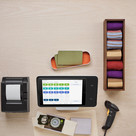Sweat public speaking? You’re not alone. Seventy-four percent of people are terrified to get in front of an audience. There’s even a name for it — glossophobia — and it’s one of the most common phobias (some research ranks it above death).
Even the most successful people on the planet aren’t immune —Richard Branson, Warren Buffet, and Nicole Kidman have all opened up about their struggles with stage fright.
Unfortunately, especially as an entrepreneur, you can’t shy away from public speaking forever. As you grow your business, you have “all-hands” meetings to run, local business gatherings to attend, and opportunities to speak at industry events. Skipping these things thwarts your success and makes you a far less motivational leader.
We’re not going to sugarcoat it. An extreme fear of public speaking is a pretty difficult thing to “get over.” In fact, you may be someone who will always be nervous in front of crowds. And that’s okay — studies actually show that a bit of anxiety can lead to an improved performance.
But if your public-speaking fear is consistently derailing, that’s limiting, not to mention extremely uncomfortable to shoulder. Luckily, there are some strategies that can help.
Understand where it comes from
As evolved as we may be, our brains can still have trouble distinguishing between real-life threats (that woolly mammoth might eat me) and imagined ones (that audience might think I’m stupid).
An awareness that it’s all just biological can help ease the panic. When you feel yourself starting to freak out, interrupt the automatic fear response with some counteracting thoughts (“that’s just my brain doing it’s thing, there is no real danger here”). Neutralizing and normalizing can help stop the spiral.
Breathe
When we’re stressed and anxious, we tend to breathe shallowly. Before you get out in front of your audience, take a few minutes for some deep breathing. Diaphragmatic breathing — that is, deep, slow breathing from your belly — helps alleviate tension and calm the mind.
When you do start speaking, don’t forget to breathe as well. Pause in between sentences to take in some air. Slow and measured breathing is a sign of control.
Expose yourself
One of the most effective ways to get over any type of phobia is exposure therapy. The method involves taking baby steps to confront your fear by exposing yourself to lower pressure situations, slowly building up to higher ones. Attend smaller meetings and events that involve some solo air time.
Public-speaking workshops like Toastmasters also offer supportive and low-threat environments to practice addressing groups. To hammer home this point, Malcolm Gladwell recommends racking up a whopping 10,000 hours of public speaking so it begins to feel like second nature.
Call it what it is
As we mentioned, the majority of people share your fear of public speaking. So if you’re feeling extremely nervous, just say so. Exposing your vulnerability puts a crack in the formality of the situation and helps to forge a human connection with your audience. Both of these things put you more at ease. (Even seasoned entertainers like Adele and Patti Smith have raised a white flag at high-pressure events).
Engage the audience
Public speaking is terrifying because you feel like all eyes are on you — which is true. But you can distribute that attention by making your presentation more interactive. An obvious way to do this is by asking the audience to answer questions or even soliciting a show of hands.
It’s also effective to crack some prepared or situational jokes to warm up the crowd, especially at the beginning of your presentation. Anything that breaks down barriers breaks down tension.
Practice, practice, practice
Sometimes it just happens — you freeze. Practicing thoroughly beforehand can be a lifesaver in those situations. Go through your presentation out loud at least five times (at separate times) to infuse it in your long-term memory. Iron out any rough spots, paying particular attention to transitions between points and slides. Smooth sequitur phrases (“this leads us to the most important point,” or “now that we’ve gone over…”) help fill what can otherwise be awkward dead space.
Inject your personality
Although practicing your presentation beforehand is key, it’s also important not to be a robot. Don’t speak in a monotone. Don’t just read off your slides. Let yourself go off script a bit. You’ll feel way more natural if you let your personality shine through. Approaching your talk as a person-to-person conversation also makes it a lot more engaging (and entertaining).
Photo credit: “Women In Tech – 156” by WOCinTech Chat, Flickr, CC by 2.0, cropped from original.
![]()











